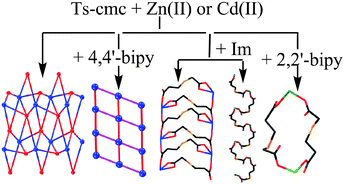A new ligand of N-(p-tosyl)-S-carboxymethyl-L-cysteine (Ts-cmc) was prepared. The reactions of Ts-cmc with Zn(II) or Cd(II) salts in the absence or presence of ancillary ligands provided five homochiral coordination polymers [Cd(Ts-cmc)]n (1), [Cd(Ts-cmc)(4,4′-bipy)(H2O)]n (2), [Zn2(Ts-cmc)2(4,4′-bipy)2(H2O)2]n (3), [Cd(Ts-cmc)(Im)(H2O)]n (4) and [Zn(Ts-cmc)(Im)(H2O)]n (5) and one discrete dinuclear compound [Zn2(Ts-cmc)2(2,2′-bipy)2(H2O)2]·2H2O (6) (4,4′-bipy = 4,4′-bipyridine, Im = imidazole and 2,2′-bipy = 2,2′-bipyridine). Complexes 1–4 crystallize in a chiral space groupP21, but 5 and 6 in chiral space groupsP212121 and C2, respectively. The interaction of 5-connected Cd(II) ions and Ts-cmc ligands of 1 without the help of any ancillary ligands led to the construction of a 2D network with 1D helices. With the aid of the bridging ancillary ligand of 4,4′-bipy another kind of 2D homochiral network was established for 2 and 3 with 4-connected metal ions and 2-connected Ts-cmc ligands. However the introduction of a monodentate ancillary ligand of imidazole into the reaction system gave a 1D double-chain made from 3-connected Cd(II) ions and Ts-cmc ligands for 4 and a 1D helix constructed from 2-connected metal ions and Ts-cmc ligands for 5. Furthermore, the chelating ancillary ligand of 2,2′-bipy resulted in the formation of a chiral discrete dinuclear structure (6) with 2-connected metal ions and Ts-cmc ligands. It was revealed that the introduction of bridging, monodentate or chelating ancillary ligands into the reaction system leads to the change of connecting modes for metal ions and Ts-cmc linkers from 5- to 2-connected modes reaching the goal of controlling the growth of dimensionalities and structures of homochiral metal-frameworks. An investigation of the fluorescence of the Cd(II) compounds as well as the free ligands indicates the emission bands of the Cd(II) compounds are due to the intraligand transmission.


 Please wait while we load your content...
Please wait while we load your content...